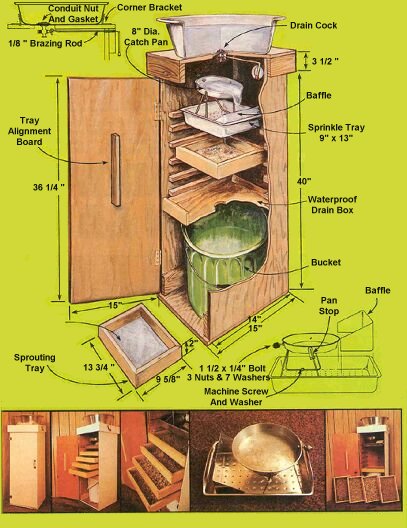
Self-Watering Sprout Cabinet
Overall Dimensions
As you can see from the cutaway drawing, this sprout box, which has overall dimensions of 16-1/2" x 16-1/2" x 41", can accommodate up to four 2" x 9-5/8" x 13-3/4" wire mesh bottomed trays, each of which ca be layered with as much as two cups (about one pound) of raw, pre-soaked seeds.
Commentary
 When
room-temperature water is poured into the sprout's mail reservoir (the basin
at the very top of the cabinet), and when the drain cock just below it is opened
slightly, water begins to drip slowly into a round cakepan below. This "catch
pan", which is supported by a frame bent up from a brass "brazing" rod (the
type welders use), is pivoted at a point to one side of it's center of gravity
or what would
be
the pans "C.G." if the container weren't counterweighted
on
that side. What happens is that when the pan is empty, it "wants" to (because
of the counterweights) rest in a horizontal position, but as the pan fills
with water it becomes increasingly unbalanced (because of the offset pivot
points) until it eventually "trips", spilling out all of the water. When the
drain cock is adjusted to give the proper drip rate, the pan trips every two
to four hours, which of course, is an ideal watering interval for sprouts.
When
room-temperature water is poured into the sprout's mail reservoir (the basin
at the very top of the cabinet), and when the drain cock just below it is opened
slightly, water begins to drip slowly into a round cakepan below. This "catch
pan", which is supported by a frame bent up from a brass "brazing" rod (the
type welders use), is pivoted at a point to one side of it's center of gravity
or what would
be
the pans "C.G." if the container weren't counterweighted
on
that side. What happens is that when the pan is empty, it "wants" to (because
of the counterweights) rest in a horizontal position, but as the pan fills
with water it becomes increasingly unbalanced (because of the offset pivot
points) until it eventually "trips", spilling out all of the water. When the
drain cock is adjusted to give the proper drip rate, the pan trips every two
to four hours, which of course, is an ideal watering interval for sprouts.
When the catch pan does dump, it spills it's water into a rectangular pan (see diagram) which has numerous holes drilled in it's bottom. (Note that the pan also has a baffle at one end to contain the "splash" that always occurs) This "third pan down the ladder" (so to speak) allows the wash water to drip and drizzle evenly over the germinating seeds in the screen bottomed trays below, which in turn causes the seedlets to perform their magic growing trick.
As you can see, the "irrigation" water after trickling down through the sprouter's four seed trays, drips into a flat, waterproofed, wooden box that has a hole in it. The water of course, then drains through the hole, right into a removable bucket in the bottom of the cabinet. The vitamin laden contents in this bucket can then be used for soups, or given to the animals.
Operation
All
the operator of the sprout box has to do, then is:
(1)Pre-soak
all seeds overnight in a warm, dark place in three times their volume of water.
(2)Dump
the soaked seeds into the screened trays (up to two cups of seeds per tray)
and spread'em out thin.
(3)Insert
the trays into their racks. (Here, it's a good idea to place trays containing
mung beans soybeans, or other strongly flavored seeds in the lowermost level(s)
of the cabinet and those containing more delicate fare-such as alfalfa seeds-in
the uppermost rack(s), so that "essence of mung" (or of soy) won't wash down
over the more subtly flavored sprouts.
(4)Fill
the units main reservoir with room-temperature water ever other day or so
(5)
Adjust
the drain cock for a one-drip-per-second flow rate.
(6)After
three or four days, harvest several pounds of delicious, vitamin packed vegetation.
Of course, whether you decide to grow sprouts by the "batch" method (which involves loading the cabinet with seeds all at once, and harvesting a large crop of sprouts all at once several days later) or by the "continuous harvest" method (which, as the name implies-calls for "sowing" a small amount, say one "tray full" of seed every day and reaping a corresponding amount of vegetation every 24 hours, is up to you. If you plan to process a large quantity of sprouts into flour, chances are you'll want to use the "batch" method. On the other hand-if you and/or your animals want to eat fresh sprouts every day, you'd probably do best to take the continuos harvest route.
Mother Earth News
Article Contributed By:
magic bean